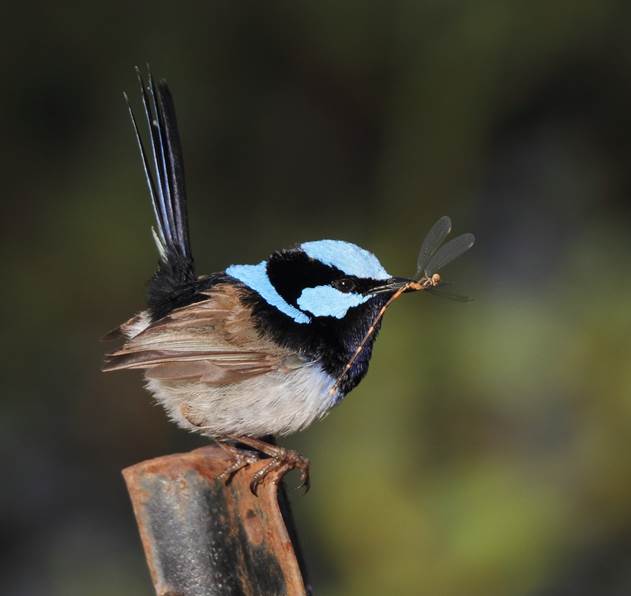Thanks, Geoff – nice record and lovely (or should that be superb?) photo. Love the way you got the rust of
the star-picket to bring out the immature coloration of the banding on the abdomen and thorax! This is a recently emerged male Wandering Ringtail (Austrolestes leda) – given the opportunity he would have matured to a bright blue and black – rivalling
the colouration of his captor.
Harvey
Dr Harvey Perkins
CRC Programme Operations
AusIndustry – Business Services
Phone +61 2 6213 7472
Internet:
business.gov.au
From: Geoffrey Dabb [
Sent: Thursday, 22 December 2016 11:32 AM
To:
Subject: FW: [canberrabirds] Day of the Dragon
Thanks Harvey. Yes I’ve certainly got video somewhere of bee-eaters with them. Rather than hunt through the holdings, I will now, appropriately alerted, keep
an eye out for further examples. I’ll include damselflies too, of which I have the below example –

From: Harvey Perkins
Sent: Thursday, 22 December 2016 8:22 AM
To: David Rees
Cc: Geoffrey Dabb; Canberra Birds
Subject: Re: [canberrabirds] Day of the Dragon
Geoff, David - some interesting observations. In all the time I've spent surveying dragonflies I've rarely seen much in the way of predation. I've seen Bee-eaters that had caught them, but that is the only bird I've seen with a captured
dragonfly. On Monday this week I witnessed an asilid (robber fly) capture and begin to eat a male Red & Blue Damselfly (which was longer than it was). Otherwise I've seen many damselflies caught in spiders' webs (mainly Tetragnathidae - long-jawed spiders).
I think the aerial abilities of dragonflies, despite the hovering tendency of some species, including the Tau Emerald, would normally give them the advantage over most birds. They often have scuffles in the air, mostly intra-specific but
also inter-specific, which might distract them and make them more vulnerable; and females might also be more vulnerable when depositing eggs. But by and large it seems to me that predation by birds is fairly uncommon. More than happy to be given further evidence
to the contrary!
On 21 December 2016 at 15:36, David Rees <> wrote:
Harvey
I was also there at the time, it appeared to me that it was an individual bird doing this, though given how good it was it might catch on.
I have updated my Australian reed warbler footage to include footage of the bird taking the wings of a dragonfly before eating it. I only had a secondary camera with me, which would not match the clarity obtained by Geoffrey with his impressive
'artillery piece'.
On Wed, Dec 21, 2016 at 8:25 AM, Harvey Perkins <> wrote:
Great shots, Geoff. The dragonfly is a Tau Emerald Hemicordulia tau. Was this all the one individual?
On 20 December 2016 at 15:44, Geoffrey Dabb <> wrote:
I spent an hour yesterday and this morning waiting for a Little Bittern, without any serious expectation of seeing one. Too few bitterns, too much typha. However there were certainly
two different birds calling yesterday. From the hide this morning one could see at least 5 dragonflies being despatched by busy RWs. The D-flies seem to be all the one species. I can confirm the RWs can snatch them from the air. That motionless hovering
might be clever, but is not necessarily advantageous from a natural selection viewpoint. Catching the insects took less time than removing the wings.
|
|

